It’s 3pm on a hot February afternoon in Thailand. The press are assembled at the media tent at Wonderfruit, Thailand’s best-known festival located at Pattaya’s Siam Country Club, two hours south of Bangkok.
Its co-founder Jira Montonn – widely known as Jay – creates a commotion as he rocks up in an electric bike with a Wonderfruit-branded metal drinking flask clinging to the bike’s wireframe.
Cutting a colourful figure, he is dressed head to toe in a white Arab-inspired outfit with multi-coloured scarves and bead necklaces around his keffiyeh (an Arabic scarf worn around the head) and declares: “The amazing thing about electric bicycles… is that look of utter surprise people give when they ride it for the first time.”
He mimics the shocked look, and everyone laughs. Montonn’s enthusiasm for all things related to sustainability – beyond his e-bike and reusable water flask - is infectious.
It is a trait shared by his partner-in-crime Pranitan “Pete” Phornprapha, who had been inspired by The Secret Garden Party, a popular independent arts and music festival in the United Kingdom, and started Wonderfruit with Montonn three years ago.
Bangkok-born Phornprapha, whose family owns Siam Motors Group and property businesses among other interests, arrives shortly after, dressed in a white shirt, black trousers, and what looks like a makeshift turban. Like Montonn, he is carrying the same metal flask.
The architect behind Wonderfruit was schooled in environmental issues from an early age thanks to the influence of his father Pornthep Phornprapha and Siam Motors’s environmental campaign, Think Earth.
The younger Phornprapha’s experience living overseas in Canada and the UK, along with influences from other festivals such as Burning Man in the United States, convinced him that the festival format – though relatively untested in Asia - was the perfect platform to raise awareness of issues such as climate change, resource use and sustainability.
“
We fool people into coming out here on the basis of having a good time… Wonderfruit is not just a music festival. It is a social movement.
It is apt, then, that festival goers are known as “Wonderers”. “Wonderfruit was set up to provoke people to think about sustainability,” Phornprapha tells Eco-Business in an interview on the sidelines of the media tour. “We’re bringing all these innovative ideas on sustainability together, but showing them in a way that’s creative and engaging, rather than being too scientific.”
But when asked about their personal motivations for Wonderfruit, both founders are quick to emphasise this: “We are not hardcore activists”.
Montonn, who is a well-known Thai musician and actor, explains: “We don’t think of ourselves that way. People often think being environmentally-responsible is a chore or is tedious, and we don’t want that.
“We fool people into coming out here on the basis of having a good time…” Montonn says, with tongue in cheek.
The roughly 10,000 “Wonderers” who come from Asia, Europe and the US for the four-day festival become a captive audience for Wonderfruit to deliver its sustainability messages.
He adds: “Wonderfruit is not just a music festival. It is a social movement.”
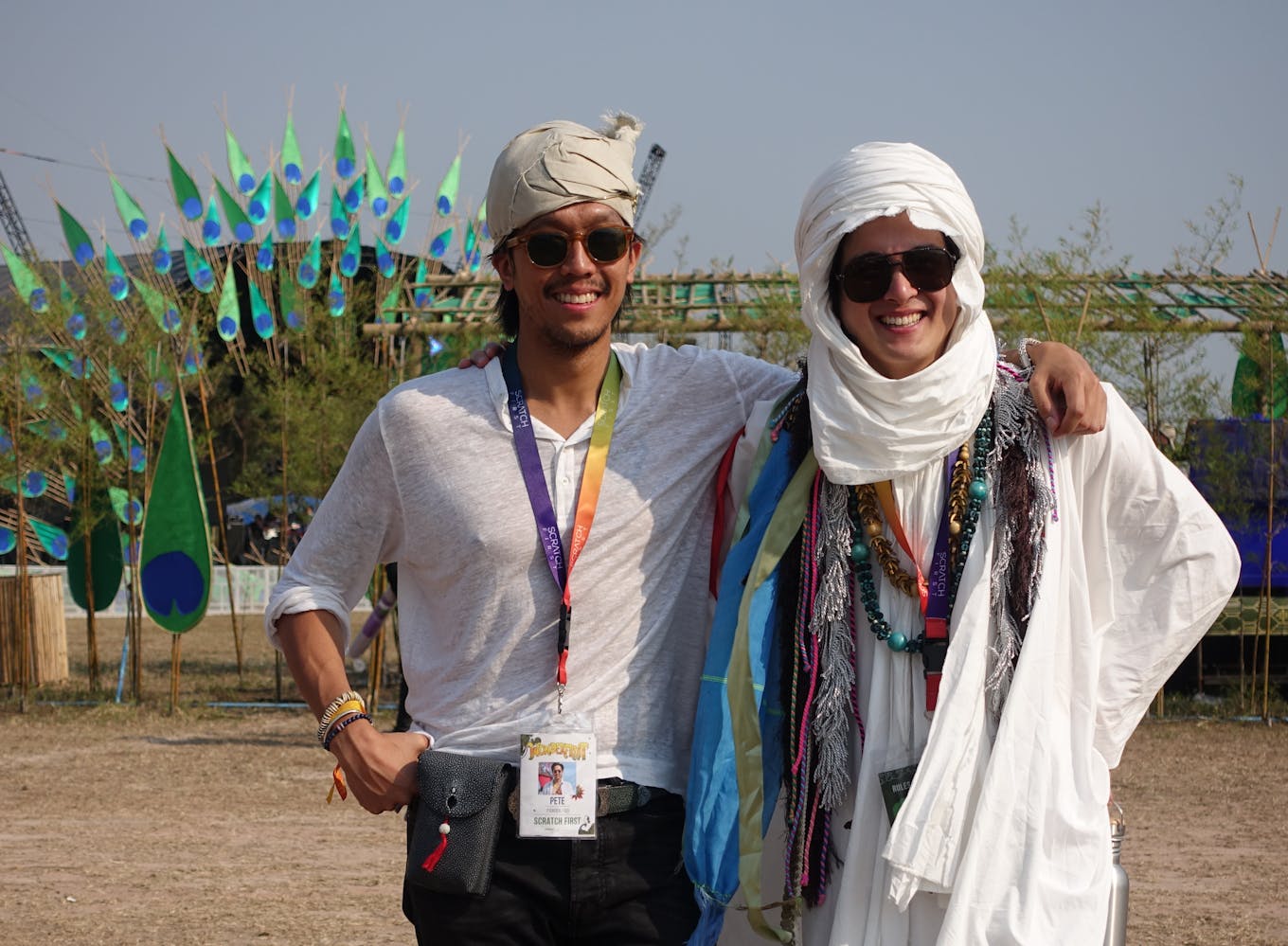
Co-founders of the Wonderfruit Festival Pranitan “Pete” Phornprapha (left) and Montonn “Jay” Jira. Image: Eco-Business
The world’s most sustainable festival?
Music festivals around the world are often notorious for their huge environment impact – from the waste they generate to the amount of energy consumed and the carbon footprint of those attending – but Phornprapha is determined for Wonderfruit to debunk this notion.
His company behind Wonderfruit, Scratch First, built a lake and commercial-grade water filtration system so the festival, which launched in December 2014, could have its own circular water supply.
The event also has a no-plastics rule and everything from the materials used to build stages to the cutlery served for food is biodegradable.
Phornprapha says for this third edition (which was meant to be in December last year but was postponed to February due to the passing of His Majesty King Bhumibol Adulyadej), Scratch First has calculated the carbon footprint of the entire festival and will offset it by investing in the Rimba Raya Biodiversity Reserve in Indonesia.
The footprint of about 10,000 participants over five days - including the event’s set up and energy usage but not accounting for travel - amounted to 3,775 tonnes of carbon, say the organisers.
In a previous interview, Phornprapha notes that other festivals such as the Burning Man in the Nevada desert claim“it leaves no trace”, but actually, “all that rubbish is just moved to Los Angeles”.
Sustainability is Wonderfruit’s “starting point”, and the fun and activities are curated around that, not the other way around, he says.
The event - which calls itself a ‘conscious festival’ promoting responsible consumption - focuses on six pillars: from art installations to music acts, food experiences to talks and workshops, wellness activities such as yoga or meditation, to family-oriented activities – and they all revolve around environmental sustainability and social responsibility.

Festival go-ers, known as “Wonderers”, participating in a yoga class, one of the many wellness and adventure activities hosted at Wonderfruit. Image: Wonderfruit Festival
The duo are obviously proud of their efforts: They take the media on an hour-long tour of the grounds to view the various initiatives, which among many include the water filtration system, the “trash monsters” (trash bins decorated like monsters) that separate food compost from recyclables, and the Farm Stage, which is based on traditional Thai ceremonial structures and built entirely outof bamboo and rice from local farmers’ fields.
There is a tacit acknowledgement, however, that the festival could be greener. When asked about how the festival generates its energy, Phornprapha says that it still relies on diesel generators, which are known to be more pollutive, due to a lack of cleaner alternatives.
Biodiesel is not available in the large quantities that they need, and efforts to find a solar firm to build a solar farm on the grounds have been futile so far, he admits.
Still, the festival features a charging station for phones at the camping area by international NGO Greenpeace powered by renewable energy that also raises awareness of greener energy sources.
Another structure built by well-known Burning Man artist Gregg Fleishman called the Solar Stage - named because it hosts music acts at sunrise and sunset - is made entirely out of sustainable wood panels slotted together without the need for screws in the artist’s signature style.
Scratch First’s ethos of “sustainability first, everything else second” brings creativity and innovation to the festival, explains Phornprapha, who adds that none of the Scratch First employees are event organisers.
“Maybe this is why we’re not making money yet,” he jokes. After three years, the festival – which costs about THB$90 million to $100 million (US$2.5 to 2.8 million) to stage - is still not breaking even, he reveals. But Phornprapha says the team is aiming for it to turn a profit by the five-year mark.
For now, it’s all about building brand value.
The business of sustainability
Wonderfruit’s brand name has been growing over the years since it was first launched and the clearest indication of that is that they are now being courted by corporates, shares Montonn.
“They see the growth in our festival attendance and this is drawing them in,” he says.
But there’s no chance of the festival selling out to brands, they insist, as Wonderfruit has a no corporate-logo policy. It is similar but less extreme than Burning Man’s, which avoids any commercial sponsorships, transactions, or advertising and calls this “decommodification”.
The Wonderfruit team curates special “brand activation” initiatives that revolve around sustainability. One example is its special “Mangrove Drink”, priced at a dollar more than the other items on the bar menu and served in a special cup. For every drink ordered, a mangrove tree will be planted in Myanmar’s Thor Heyerdahl Climate Park. The initiative was created for Diageo; although there was no mention of its brand, one of its vodka brands were used in the drink.
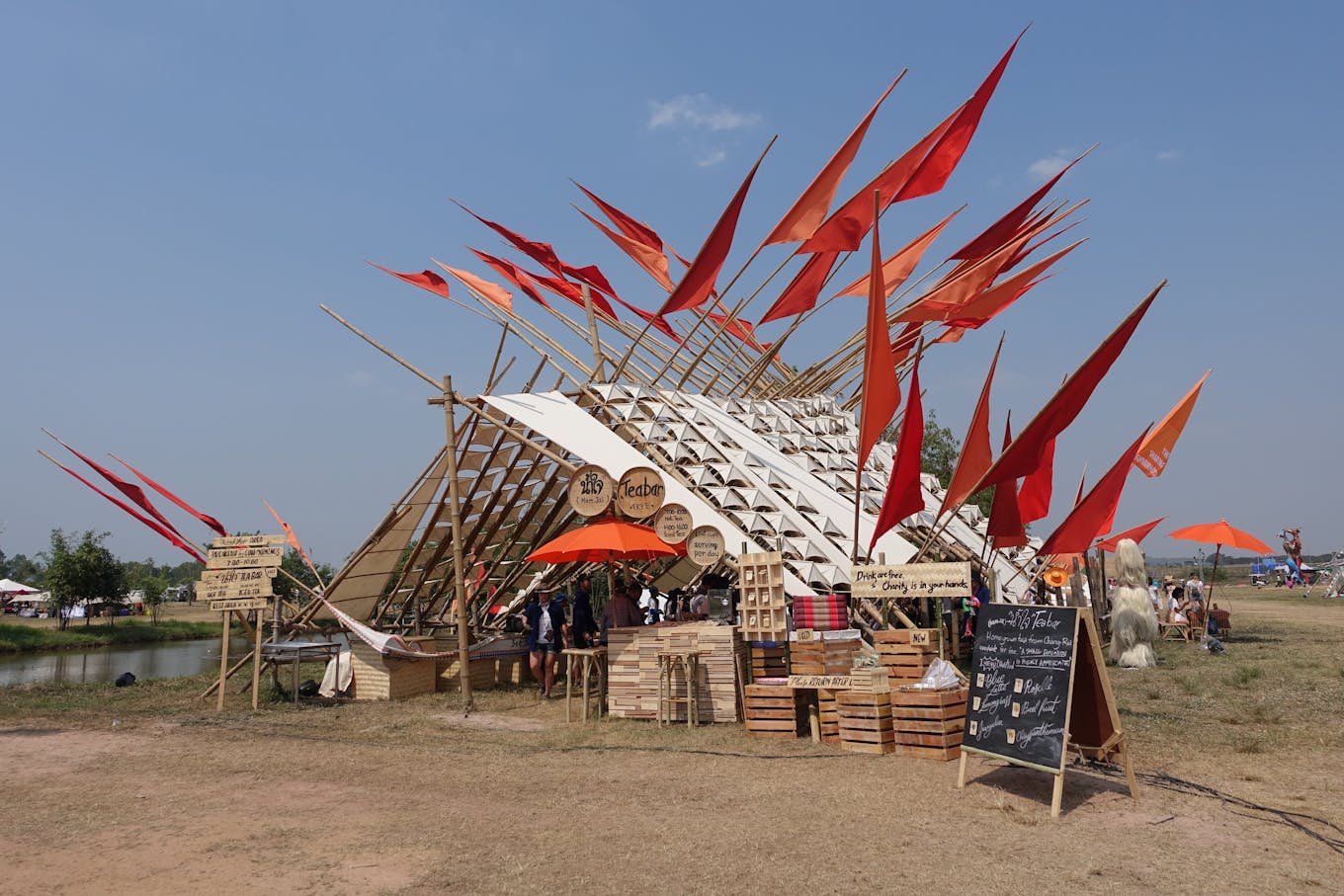
The Sharing Neighbourhood is built with sustainable bamboo and offers up free tea for ‘Wonderers’ and local cultural activities to promote the idea of a shared community. Image: Eco-Business
Another example of such a partnership is ‘The Sharing Neighbourhood‘ area at Wonderfruit, led by Thai real estate company SC Asset, which is built with sustainable bamboo and promotes the idea of the shared community by offering activities centred around local food and culture. Here, Wonderers can also make donations to help Thais in the south who have lost their homes due to flooding.
“Throughout the festival, there are mini campaigns led by businesses to create awareness for their initiatives and their brands,” says Montonn.
When asked how they respond to people who are cynical about corporate involvement, Montonn’s response is unequivocal: “We need to engage companies”.
About half of their costs are covered by big name sponsors at the moment. Thai silk company Jim Thompson, for example, provides an installation called The Molam Bus Project, and around the fields recycled silk from its factories are used to decorate tents.
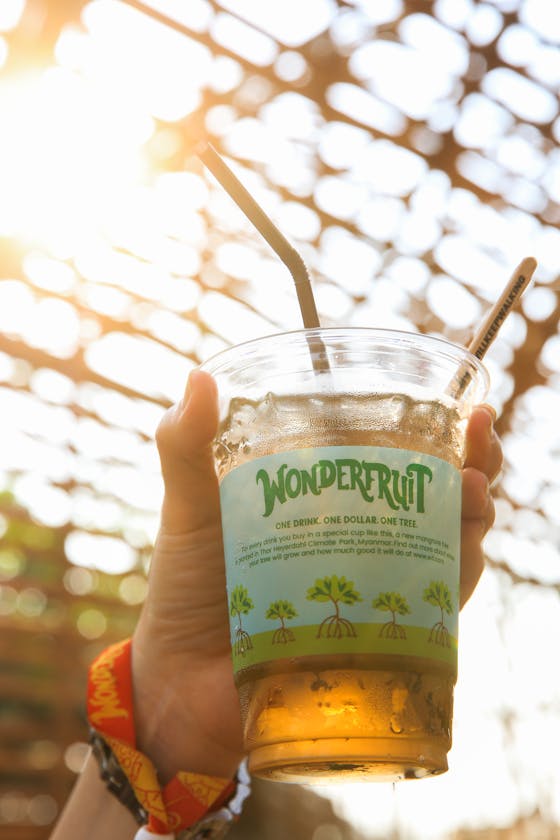
Buy a Mangrove Drink and one mangrove tree is planted in Myanmar’s Thor Heyerdahl Climate Park. Image: Wonderfruit Festival
But even while they work with businesses, the founders maintain that they do not allow any content or initiatives that do not pass their sustainability test.
Thai businesses are waking up to the concept of corporate sustainability and, says Montonn, “we want all businesses to move towards that”.
“
We’re looking to go deeper… for innovations and disruptive models of thinking about sustainability.
Companies are also starting to talk about the Sustainable Development Goals (SDGs) – a set of global development targets devised by the United Nations – and Phornprapha says Wonderfruit is often cited as an example of “creative sustainability” in Thailand and is featured in new book called Thailand’s Sustainable Development Sourcebook.
Phornprapha hopes for Wonderfruit to create mass awareness of sustainability so that people “can take that back to their own businesses”.
Meanwhile, he is pushing the boundaries with what they can do to make the festival better.
Building with sustainable materials like bamboo is just the basics, he says. “We’re looking to go deeper… for innovations and disruptive models of thinking about sustainability,” he adds. For example, the duo is looking into a new initiative that will turn rainforests into capital, but they’re not ready to reveal details.
So how do they know if their strategy is working? Is it possible to tell if their sustainability message is getting through?
“That’s a tough question”, Pete admits. “It’s hard to track this and in terms of the scale of change we need, it’s nowhere near enough”. But that’s why Wonderfruit was created: to make sustainability sexy by using the arts, he adds.
Montonn offers this: “For us, the growing number of people at the Festival is a measure of success. Sustainability has become our edge, our identity. It’s reflected in the content… We want people who come to feel that they have this common interest.”
When asked if they would take the festival to other locations around Asia, Phornprapha says they have been approached by other event companies to franchise their festival model.
But the founders insist that Wonderfruit will always be held in Thailand, where they are from. They are, however, exploring mini-events to be held in Asian cities that focus on each of the six pillars of the festival. One focusing on food to be held in Bangkok is in the works.
For the time being, they are squarely focused on boosting attendance - their target is to grow it to 15,000 from the current 10,000 - and have already started planning for the next edition of the festival, which will take place from 14 to 17 December 2017. Tickets for a four-day pass are priced around THB4,200 (US$120).
“We work all year round for this, and we have once a year to try it out, so we try to get things right each time,” says Montonn.
As we come to the end of the tour and interview, Phornprapha and Montonn pose for the media in a photo opportunity – and then invite the motley media crew to join them for a group photo.
It is this spirit of inclusivity that seems to infuse Wonderfruit. They say their goodbyes: Phornprapha drives off in a buggy, and Montonn gets on his e-bike.
“Have to do a Facebook Live event now,” he tells us. “You know, spread the message.”
Wonderfruit: In Pictures
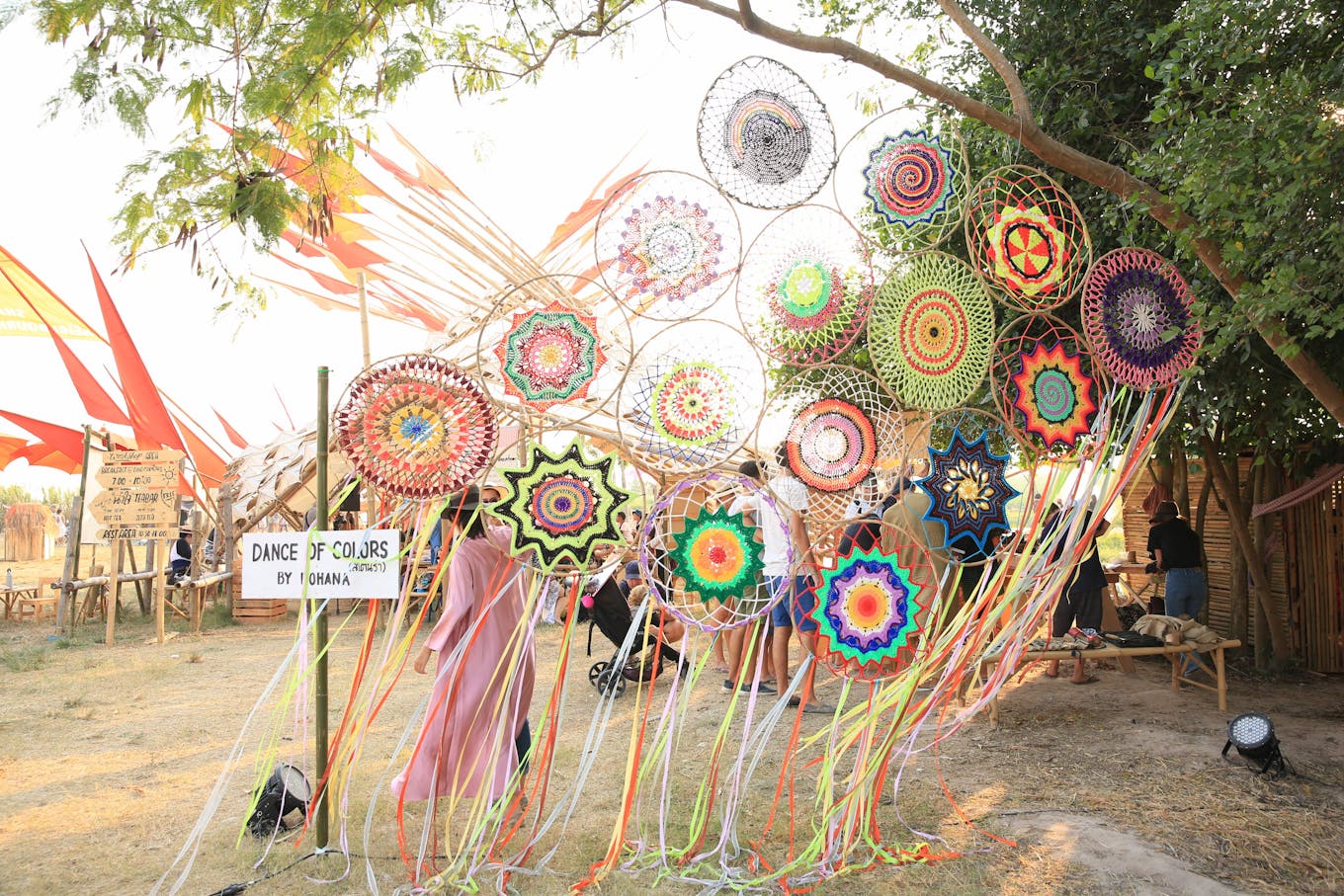
Art installations by local and regional artists are dotted all across the festival grounds. Image: Wonderfruit Festival
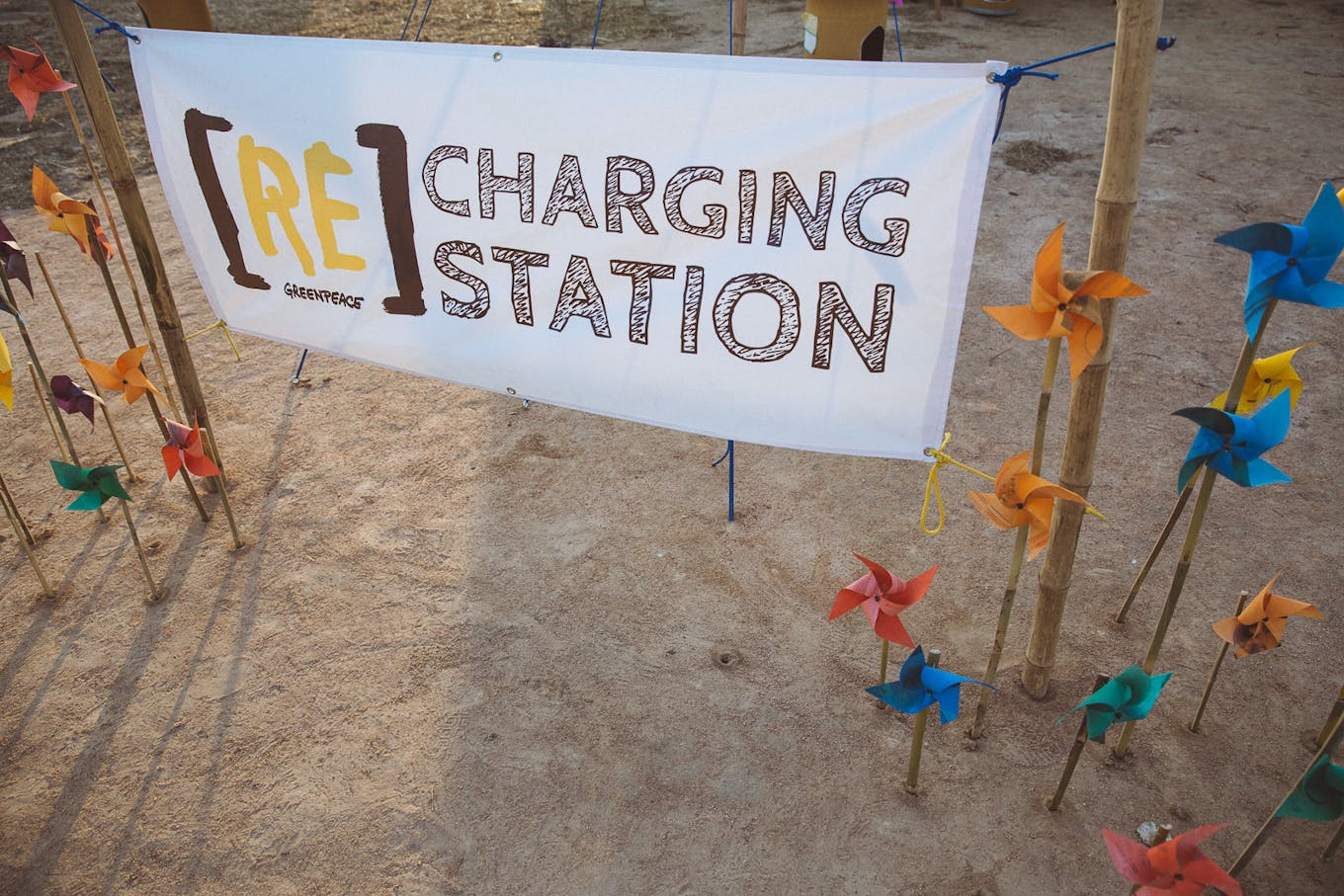
The [RE]Charging Station by Greenpeace Southeast Asia allows festival goers to charge their phone at stations powered by wind and solar energy. Image: Wonderfruit Festival

Trash monsters: The bins, which separate food waste from recyclables and general waste, are decorated as monsters using recycled material in this year’s edition of the festival. Image: Wonderfruit Festival
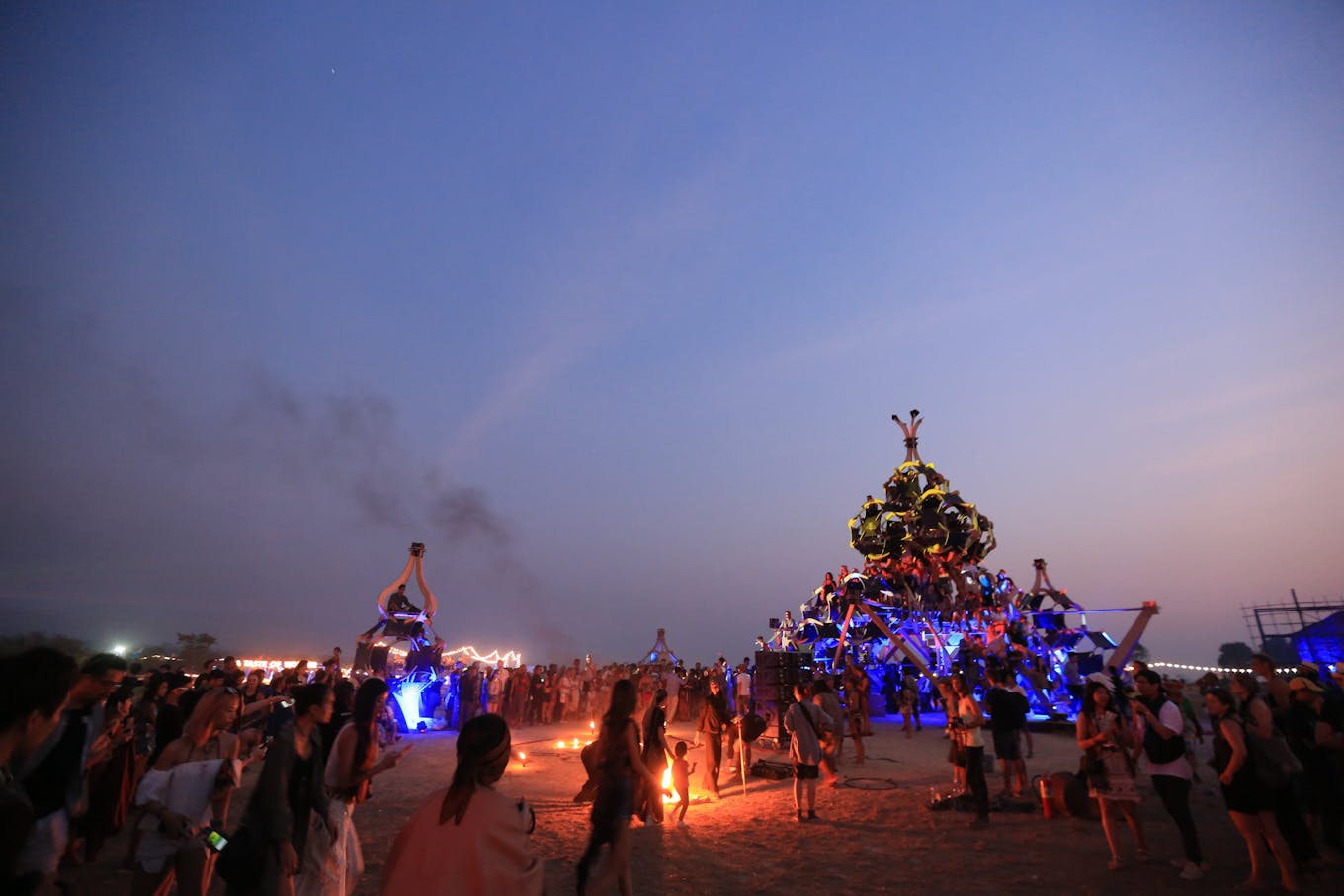
Wonderers gather at dusk around the Solar Stage, designed by Burning Man artist Gregg Fleishman. Image: Wonderfruit Festival
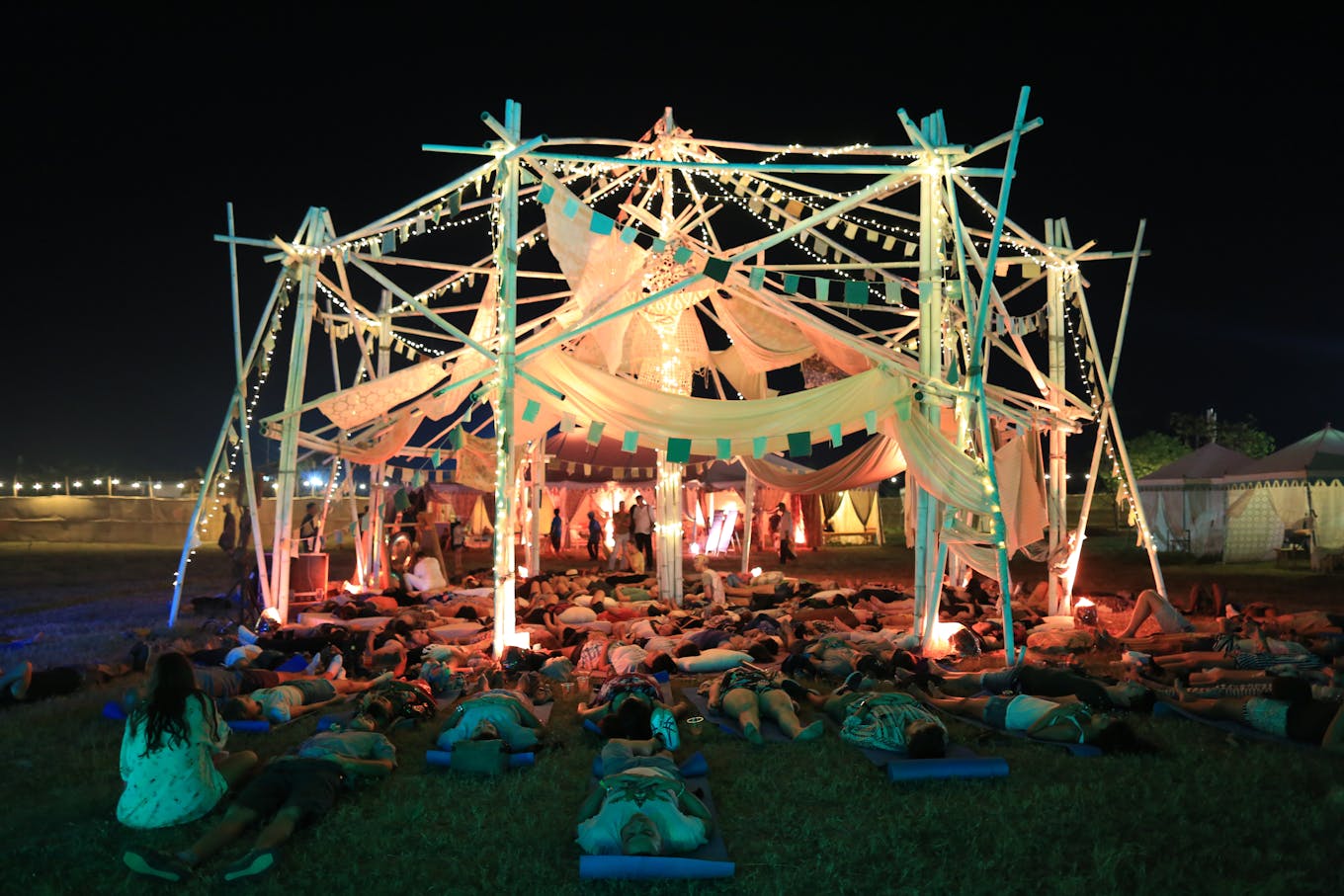
‘Wonderers’ in a mindfulness activity held in one of Wonderfruit’s tents. The festival also featured talks and workshops by speakers around the region working on sustainability-related initiatives. Image: Wonderfruit Festival
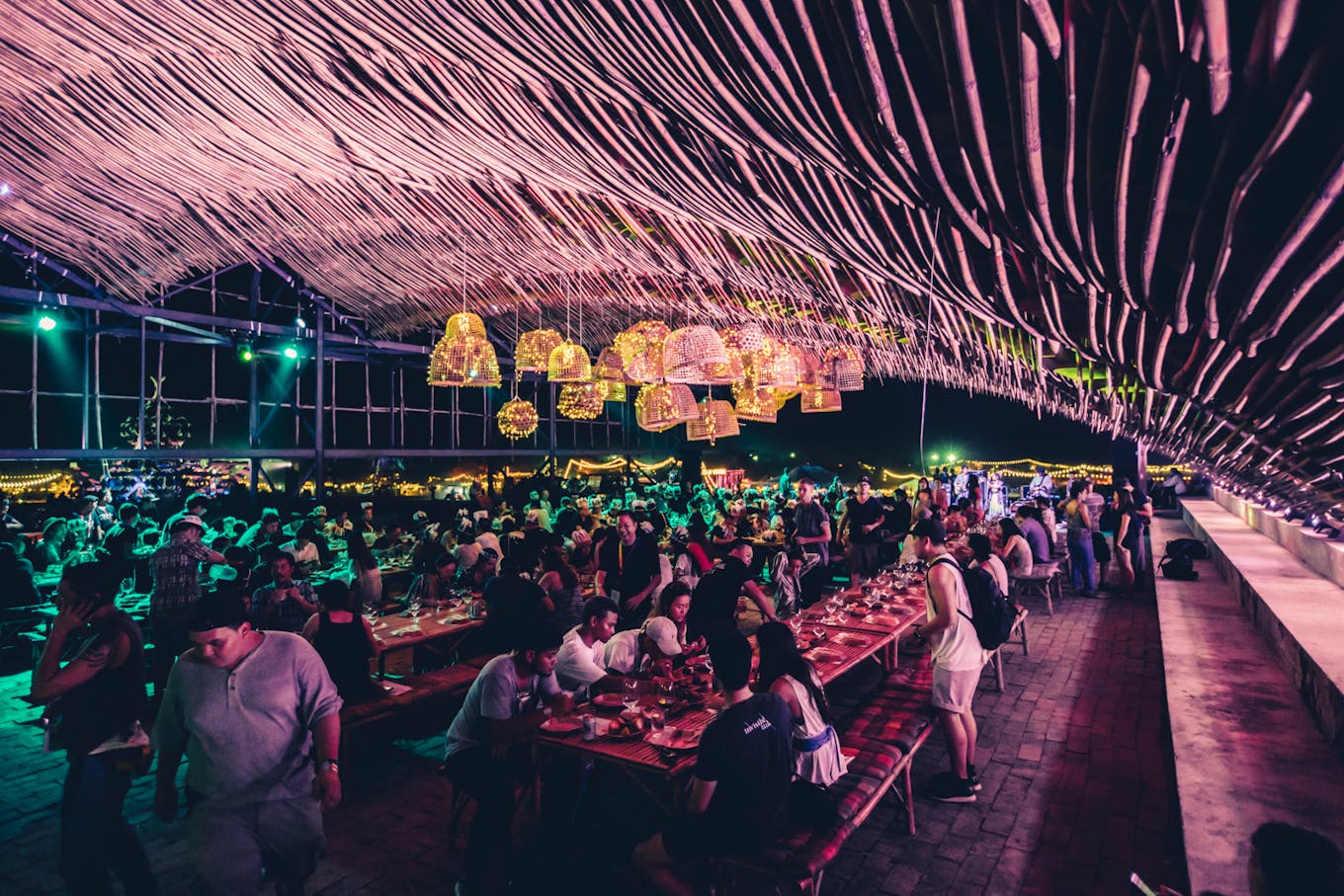
Wonder Feasts is the festival’s gastronomic outdoor offering, created by famous chefs from around the region. Image: Wonderfruit Festival

The Farm Stage, made entirely from bamboo and rice, celebrates Thailand’s traditional rice farming culture and the ceremonies that surround it. The stage hosted some renowned music acts like Buke and Gase, Yena, Superglasses Ska Ensemble. Image: Wonderfruit Festival

Rudimental, a London four-piece drum and bass outfit rocks The Fields with their full live band, complete with trumpets and guest singers. Image: Wonderfruit Festival
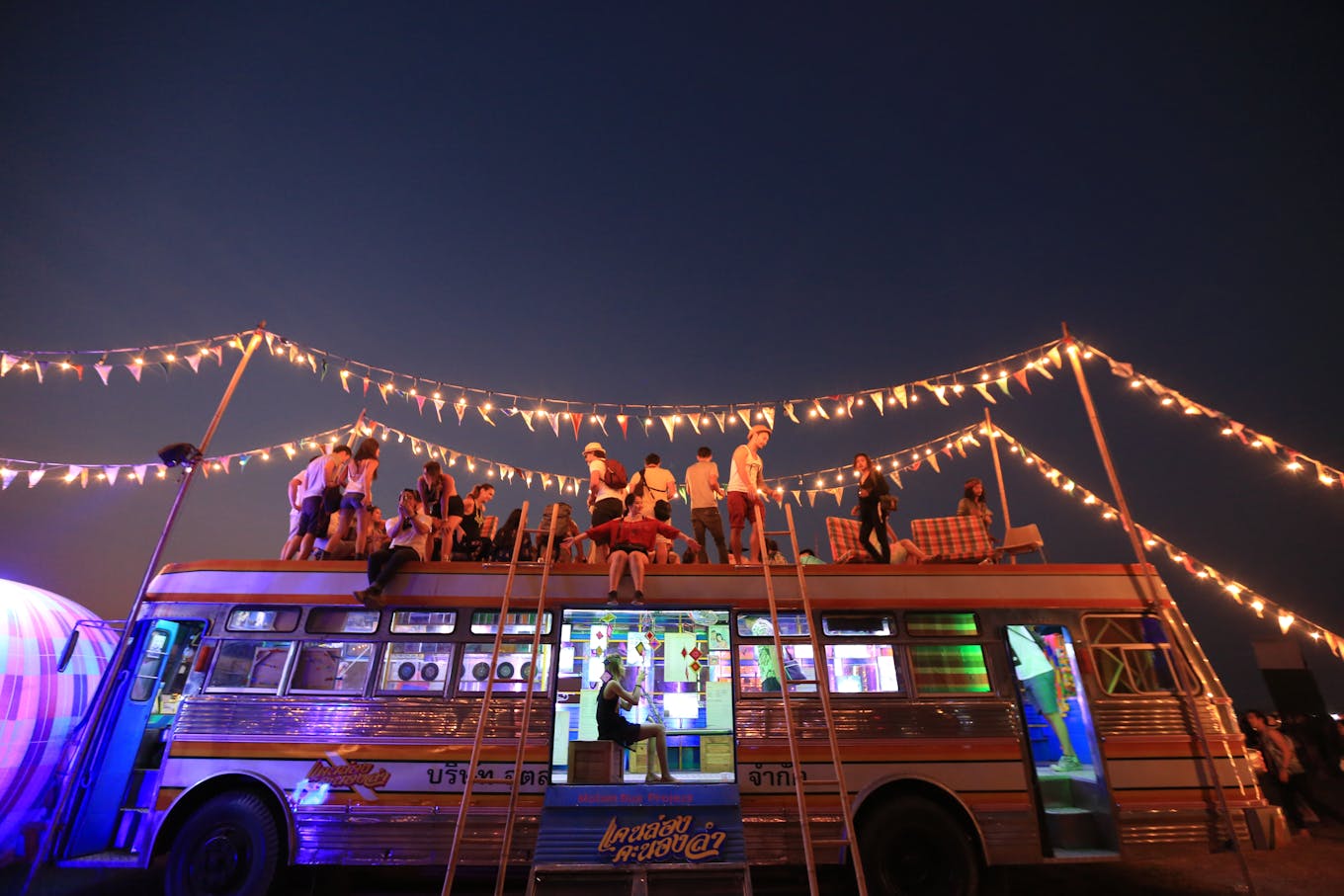
The Molam Bus Project by Jim Thompson Arts Centre provides a unique platform at Wonderfruit for musicians and festival goers alike. Image: Wonderfruit Festival















